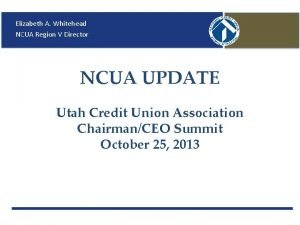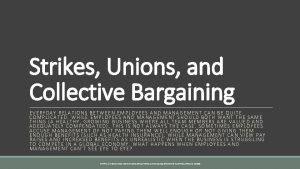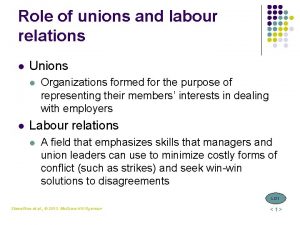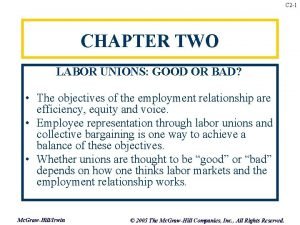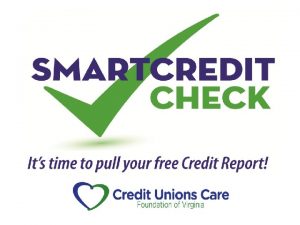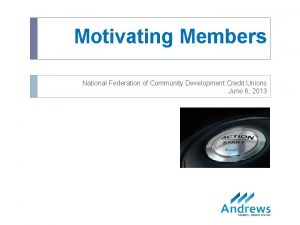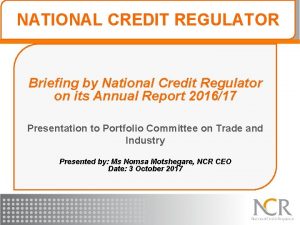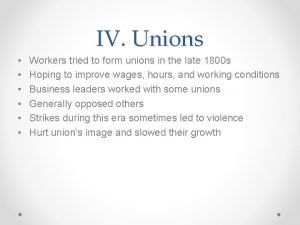National Federation of Community Development Credit Unions May


















- Slides: 18

National Federation of Community Development Credit Unions May 16, 2014 Alex Horowitz, Research Manager www. pewtrusts. org/small-loans

Pew’s Small-Dollar Loans Research • Payday Lending in America series (3 reports) • Research began in 2011 – Unique, nationally representative survey of payday borrowers – Administrative data reviews – Focus groups and interviews www. pewtrusts. org/small-loans 2

How Payday Loans Work • Packaged as “short-term” loan for “temporary needs” – Obtained from storefronts, online, some banks (“deposit advance”) • Little to no underwriting – Borrower has an income source and checking account • Lender can debit bank account to collect (deferred presentment) • Short repayment period, tied to borrower pay cycle – If borrower cannot pay in full, pays fee to renew, or borrows again • Avg. loan is $375 – Fee per 2 wks: $55 store, $95 online, $35 bank www. pewtrusts. org/small-loans 3

Profile of Payday Borrowers • 12 million users per year, spending > $7 billion • Have a checking account These are bank/CU customers • Have income – about $30, 000 per year • “Thick File” credit histories – More than 90% have a credit score – low 500 s – Most have credit cards – usually maxed out www. pewtrusts. org/small-loans 4

Most Use Payday Loans for Monthly Bills www. pewtrusts. org/small-loans 5

A Core Problem: — Payday Loans Are Fundamentally Unaffordable • Typical payday loan takes 36% of borrower’s pretax paycheck – Far too much – undermines ability to meet other financial obligations without borrowing again. • But what percentage would be more reasonable? • Most borrowers cannot afford to pay more than 5% of their pretax paycheck – As shown by national survey data, underwritten installment loan markets, conventional payday loan fee amount, CO case study www. pewtrusts. org/small-loans 6

Renewing is Affordable, But Paying Off is Not www. pewtrusts. org/small-loans 7

A Core Problem: — Business Model is Predicated on Extended Use • Nearly all loans go to repeat borrowers – 97% of loans go to those using 3+ per year – 63% of loans go to those using 12+ per year • Consecutive usage is the norm – 80% of loans originate w/in 14 days of a previous loan • The business model is predicated on these outcomes – 4 to 5 loans before average customer is profitable (industry estimate) • Average customer in debt 5 months of year, spending $520 to repeatedly borrow $375 Sources: Analysis of state regulatory data; CFPB; Industry filings; Stephens Inc. www. pewtrusts. org/small-loans 8

A Market Lacking Price Competition How much does a $500 payday loan cost? Advance America Ace Cash Express Check into Cash Check n Go Florida $55 $53 $55 Michigan $65. 45 --- $65. 45 Kansas $75 $75 Alabama $87. 50 Nevada $92. 50 $85 $110 $125 Costs listed on company websites www. pewtrusts. org/small-loans 9

A Market Lacking Price Competition State grouping Average cost to borrow $300 for 5 months Median stores per 100, 000 residents Lower than average rate cap $281 3. 0 Average rate cap $435 7. 2 Higher than average rate cap $528 14. 9 No rate cap $604 12. 9 www. pewtrusts. org/small-loans 10

Outcomes: Lump Sum Payday Loan vs. No Payday Loan Harm Benefit Mixed Melzer (food stamps) Morse (natural disasters) Bhutta et al (credit score) Skiba & Tobacman (bankruptcy) Edmiston (use of credit) Hynes (crime, unemployment) Carrell & Zinman (reenlistment eligibility) Melzer (delinquency) Campbell et al (bank account loss) Morgan & Strain (bounced checks) Zinman (employment) Bhutta (delinquencies, overdrawing credit lines) Wilson et al (lab game) Caskey (lit. review) Chang & Perry (food insecurity) www. pewtrusts. org/small-loans 11

Outcomes: Colorado’s 2010 Law Change Lump Sum vs. Affordable Installments Averages Before After Change Annual cost $476 $277 -42% Payment $429 $47 -89% Share of Paycheck 38% 4% -89% Same-day renewals/reborrows 61% 30% -51% Defaults/borrower per year 0. 49 0. 34 -30% Borrower income $29, 496 $29, 724 1% Payday stores 505 238 -53% Population within 20 miles of a store 93% 91% -2% Customers per store 554 1000 81% Revenue per store $188, 000 $185, 000 -2% www. pewtrusts. org/small-loans 12

Outcomes: Lump Sum Payday Loan vs. Installment Loan Outcome of Colorado’s reform: 1. Maintained access to credit 2. Kept lenders in business (half of stores still open) 3. Payments affordable (4% of paycheck now vs. 38% before) 4. Average borrower spends less ($277 now vs. $476 before) 5. Lender-charged bounced-check fees down 57% 6. Defaults per year have declined 30% 7. Making the loan safer and more affordable meant less oversight required to ensure consumer safety 8. Credit counselors and elected officials report fewer people coming to them with payday loan problems www. pewtrusts. org/small-loans 13

Borrowers Overwhelmingly Support Requiring Installment Payment Structure Smaller Amortize Payments Smaller Payments More Time Smaller Installments Payments 14

1. Millions turning to prepaid cards • 5% of adults using (GPR) prepaid cards at least monthly • Conversely, many who use alternative services also have a bank/CU account www. pewtrusts. org/prepaid 15

2. Desire for control is driving prepaid adoption • Why are so many people looking for financial services outside the banking system? www. pewtrusts. org/prepaid 16

3. Prepaid users do not want overdraft or automated credit www. pewtrusts. org/prepaid 17

www. pewtrusts. org/small-loans Government Relations: Steve Abbott 202. 540. 6647 sabbott@pewtrusts. org Project Director: Nick Bourke 202. 552. 2123 nbourke@pewtrusts. org Research: Alex Horowitz 202. 540. 6315 ahorowitz@pewtrusts. org
 National federation of community development credit unions
National federation of community development credit unions Inherent risks examples
Inherent risks examples Credit unions are for-profit organizations. true false
Credit unions are for-profit organizations. true false Building society vs bank
Building society vs bank Interest rate risk credit unions utah
Interest rate risk credit unions utah Am i at school
Am i at school National federation spirit rules book
National federation spirit rules book Nfhs wrestling rule changes
Nfhs wrestling rule changes This can be avoided by giving credit where credit is due.
This can be avoided by giving credit where credit is due. History in community
History in community West kenya union conference
West kenya union conference Advantages and disadvantages of unions for employees
Advantages and disadvantages of unions for employees Trade union rights
Trade union rights Labour movement in india
Labour movement in india Strikes unions and collective bargaining
Strikes unions and collective bargaining Different types of unions
Different types of unions Benefits of trade unions
Benefits of trade unions What are unions
What are unions How to simplify a union
How to simplify a union




